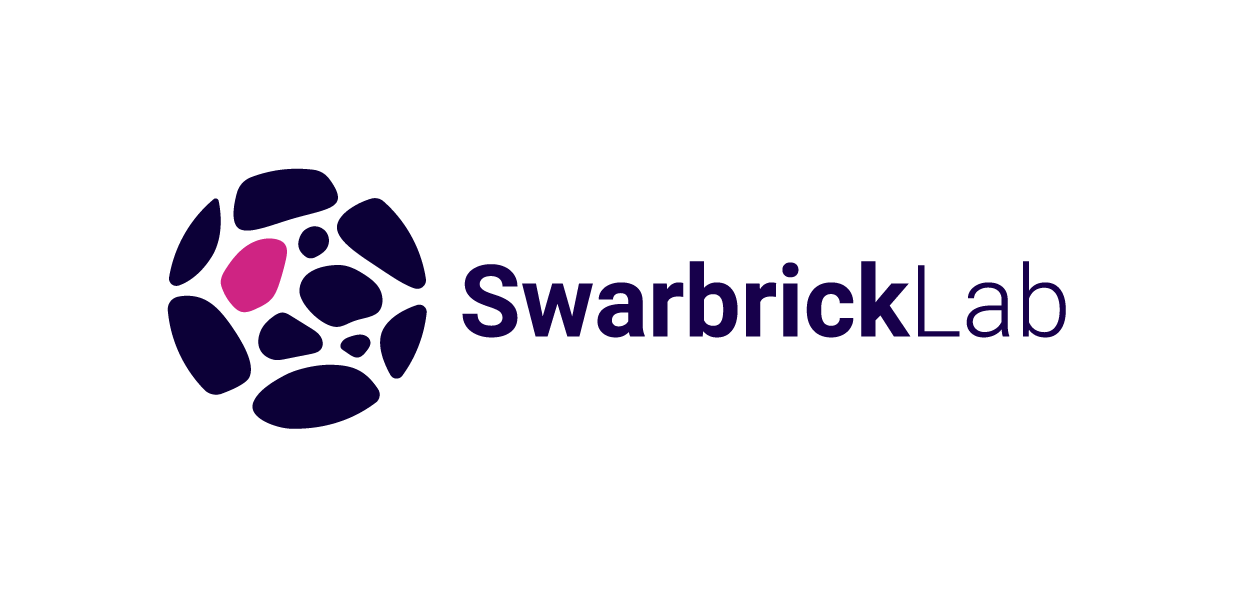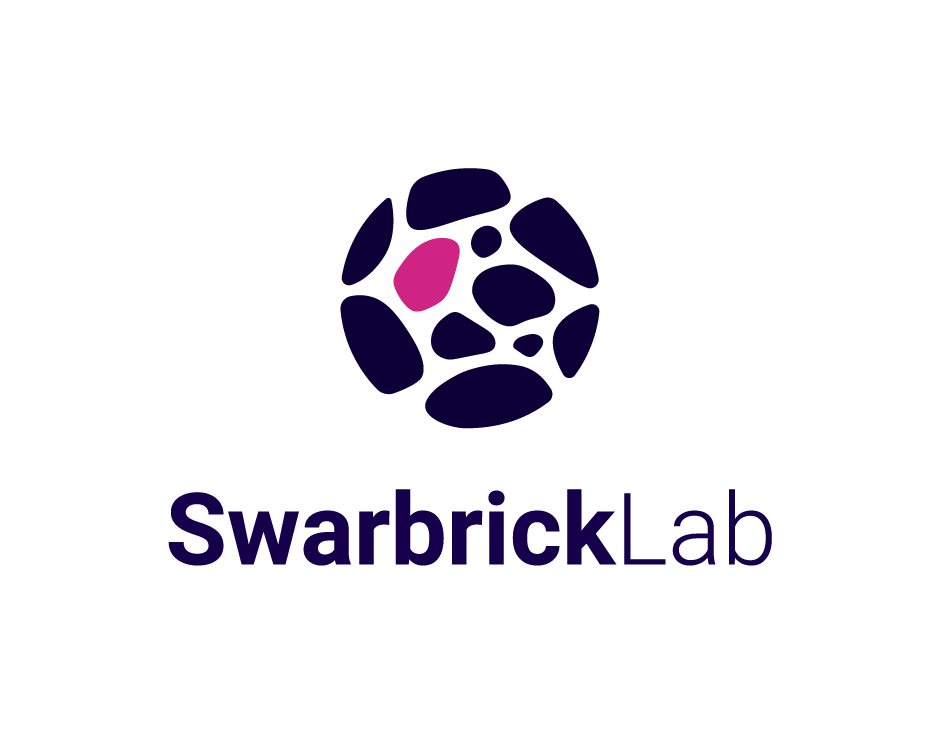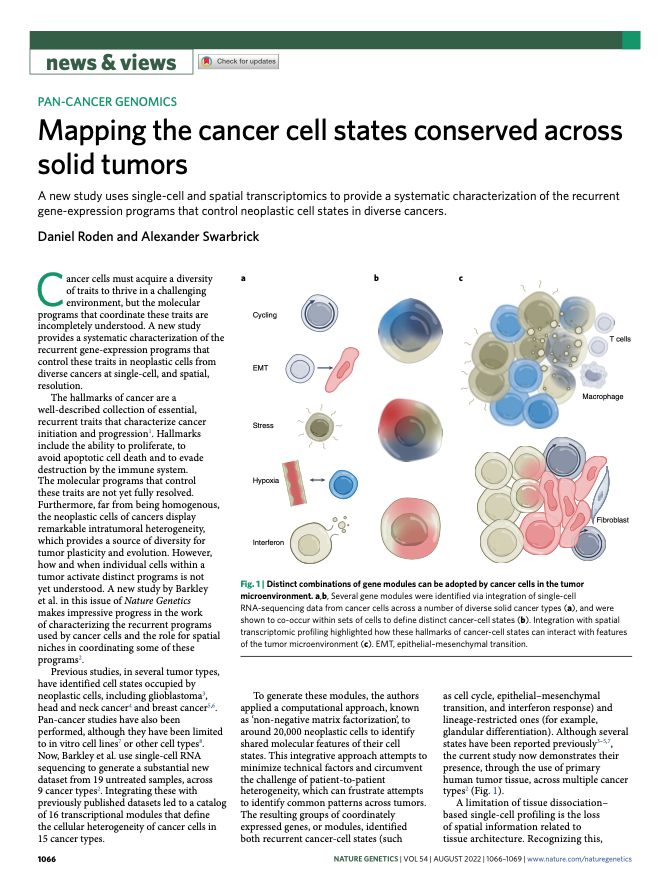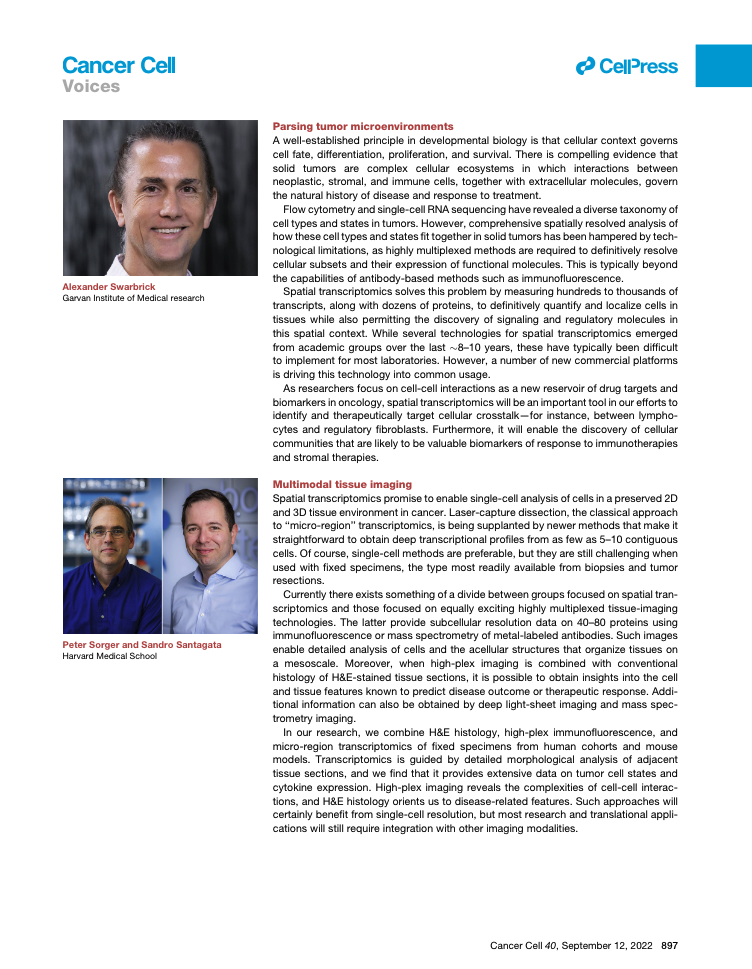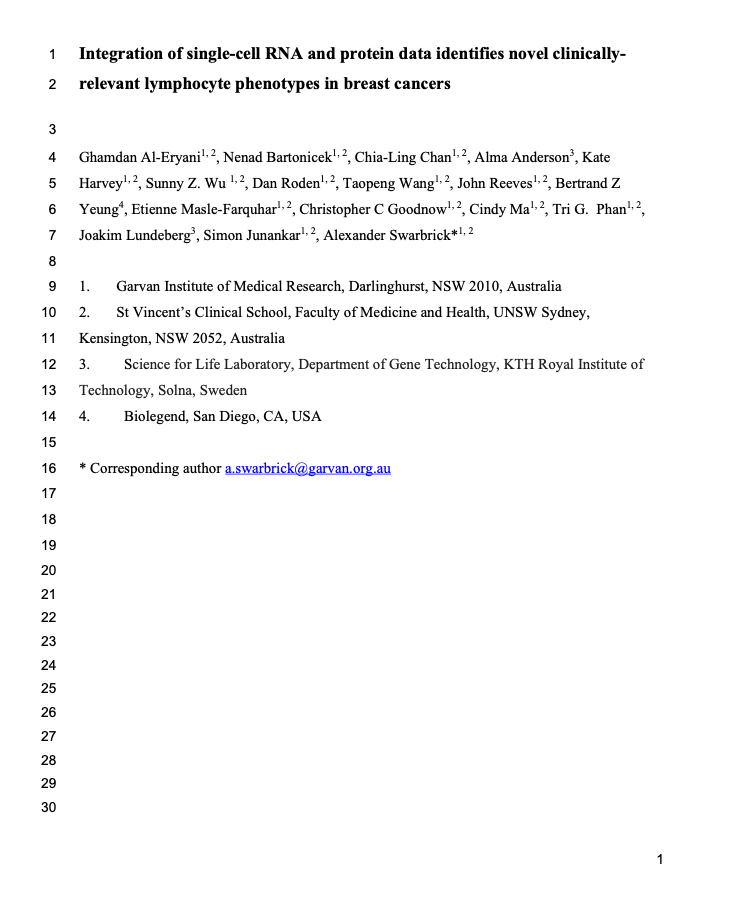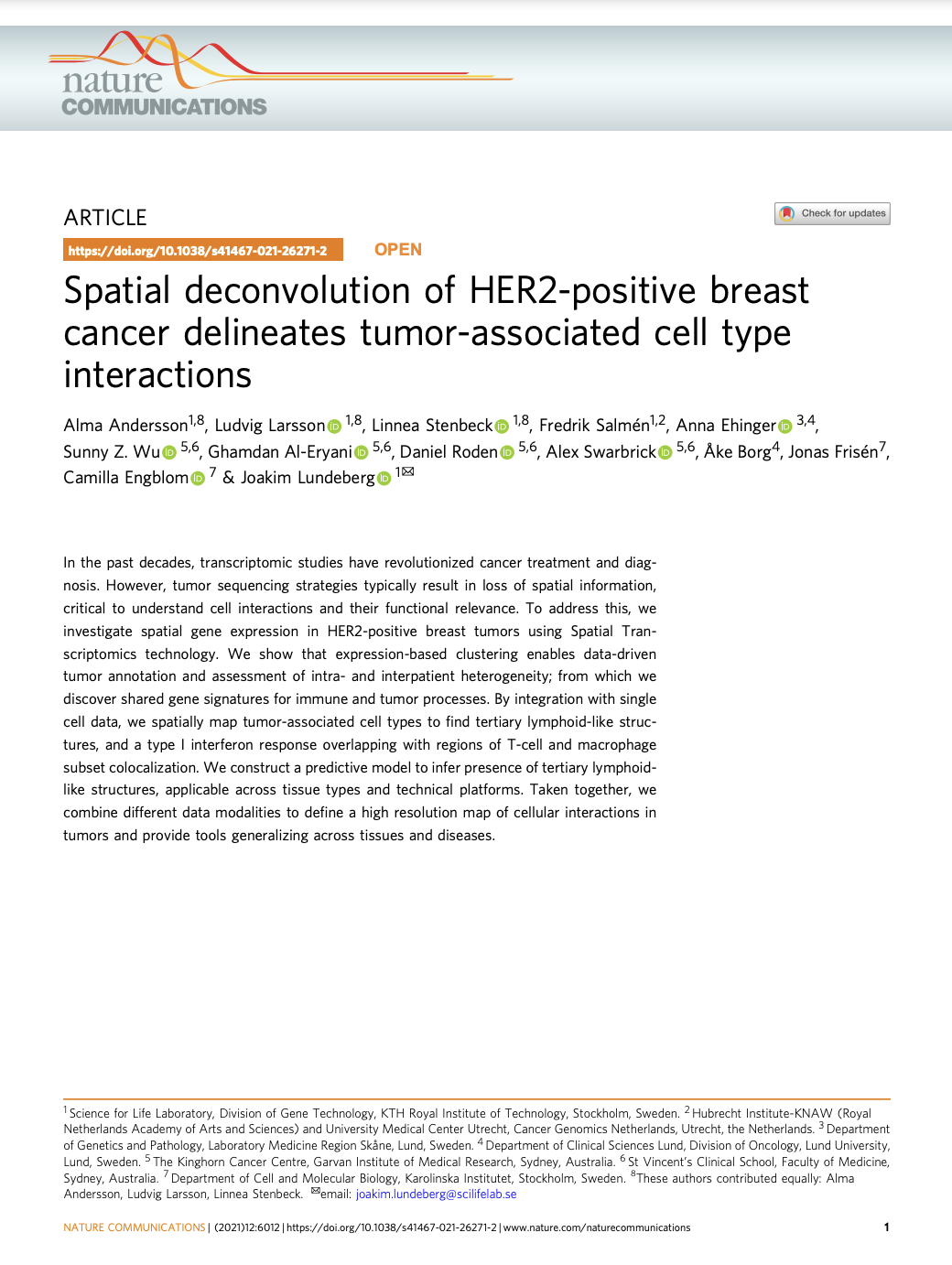Recent publications
Selected recent publications
Gene-Expression Profiling to Decipher Breast Cancer Inter-and Intratumor Heterogeneity
Swarbrick A*., Fernandez-Martinez A., Perou C.M.
*Corresponding author
Cold Spring Harbor Perspectives in Medicine, 2024
High-throughput targeted long-read single cell sequencing reveals the clonal and transcriptional landscape of lymphocytes.
Singh, M., Al-Eryani, G., Carswell, S., Ferguson, J.M., Blackburn, J., Barton, K., Roden, D., Luciani, F., Giang Phan, T., Junankar, S., Jackson, K., Goodnow, C.C., Smith, M.A., Swarbrick, A
Nature Communications, 2019
We solved a technical challenge of how to affordably and rapidly profile gene expression in tandem with full-length single molecule mRNA sequencing from thousands of cells. We developed this method to permit deep profiling of lymphocyte gene expression and receptor expression. We use it to show clonal expansion and trafficking of lymphocytes from the lymph node to tumour, and unique gene expression features of clonal populations. We are now extending this method to enable very deep cellular characterisation of molecular features such as splicing, recombination, mutations and gene fusions in cancer cell populations.
Baldwin L.A., Bartonicek N., Yang J., Wu S.Z., Deng N., Roden D.L., Chan C.-L., Al-Eryani G., Zanker D.J., Parker B.S., Swarbrick A., Junankar S.
Nature Communications, 2022
This paper shows that clonal diversity within cancers can contribute to immune evasion, during metastatic progression and during the response to immune checkpoint inhibitors
Deng N., Minoche A., Harvey K., Li M., Winkler J., Goga A., Swarbrick A.
Breast Cancer Research, 2022
Spatial maps of genetically diverse breast cancer cells
Al-Eryani G., Swarbrick A.
Nature, 2022
Mapping the cancer cell states conserved across solid tumors
Roden D., Swarbrick A.
Nature Genetics, 2022
A single-cell and spatially resolved atlas of human breast cancers
Wu S.Z., Al-Eryani G., Roden D.L., Junankar S., Harvey K., Andersson A., Thennavan A., Wang C., Torpy J.R., Bartonicek N., Wang T., Larsson L., Kaczorowski D., Weisenfeld N.I., Uytingco C.R., Chew J.G., Bent Z.W., Chan C.-L., Gnanasambandapillai V., Dutertre C.-A., Gluch L., Hui M.N., Beith J., Parker A., Robbins E., Segara D., Cooper C., Mak C., Chan B., Warrier S., Ginhoux F., Millar E., Powell J.E., Williams S.R., Liu X.S., O’Toole S., Lim E., Lundeberg J., Perou C.M., Swarbrick A.
Nature Genetics, 2021
This study maps the cellular landscape of primary breast cancers, focussing primarily on cellular states. We define a detailed cellular taxonomy of up to 52 states across epithelial, stromal & immune cells & develop a new single-cell classifier of intrinsic subtype, ‘scSubtyper’ (provisional patent application filed). Using spatial transcriptomics we map these cells into cellular communities, revealing the important spatial relationships between certain subsets of stromal cells & lymphocytes, which we are now pursuing as therapeutic targets. Finally, we reveal that breast cancers can be stratified into clinically-meaningful groups based on their cellular composition, a concept we coin ‘ecotypes’ (provisional patent application filed). This is a landmark paper in breast cancer research.
Targeting stromal remodeling and cancer stem cell plasticity overcomes chemoresistance in triple negative breast cancer.
Cazet, A.S., Hui, M.N., Elsworth, B.L., Wu, S.Z., Roden, D., Chan, C.L., Skhinas, J.N., Collot, R., Yang, J., Harvey, K., Johan, M.Z., Cooper, C., Nair, R., Herrmann, D., McFarland, A., Deng, N., Ruiz-Borrego, M., Rojo, F., Trigo, J.M., Bezares, S., Caballero, R., Lim, E., Timpson, P., O'Toole, S., Watkins, D.N., Cox, T.R., Samuel, M.S., Martin, M., Swarbrick, A
This manuscript is a key demonstration of the influence of the tumour microenvironment in driving cancer cell plasticity during drug treatment. Fundamental discoveries and preclinical modeling by my lab drove the development of a Phase I trial of an anti-neoplastic (docetaxel) + an anti-stromal (smoothened/hedgehog inhibitor) combination therapy for metastatic TNBC, in which 3/11 women experienced clinical benefit, including one complete response. While small patient numbers, this is early evidence for clinical response to a stromal-directed therapy. Larger clinical trials are in development.
miR-99b-5p, miR-380-3p, and miR-485-3p are novel chemosensitizing miRNAs in high-risk neuroblastoma
Holliday H., Yang J., Dodson E., Nikolic I., Kamili A., Wheatley M., Deng N., Alexandrou S., Davis T.P., Kavallaris M., Caldon C.E., McCarroll J., De Preter K., Mestdagh P., Marshall G.M., Simpson K.J., Fletcher J., Swarbrick A.
Molecular Therapy, 2022
Andersson A., Larsson L., Stenbeck L., Salmén F., Ehinger A., Wu S.Z., Al-Eryani G., Roden D., Swarbrick A., Borg Å., Frisén J., Engblom C., Lundeberg J.
Nature Communications, 2021
Evaluation of FGFR targeting in breast cancer through interrogation of patient-derived models
Chew N.J., Lim Kam Sian T.C.C., Nguyen E.V., Shin S.-Y., Yang J., Hui M.N., Deng N., McLean C.A., Welm A.L., Lim E., Gregory P., Nottle T., Lang T., Vereker M., Richardson G., Kerr G., Micati D., Jardé T., Abud H.E., Lee R.S., Swarbrick A., Daly R.J.
Breast Cancer Research, 2021
Wu S.Z., Roden D.L., Al-Eryani G., Bartonicek N., Harvey K., Cazet A.S., Chan C.-L., Junankar S., Hui M.N., Millar E.A., Beretov J., Horvath L., Joshua A.M., Stricker P., Wilmott J.S., Quek C., Long G.V., Scolyer R.A., Yeung B.Z., Segara D., Mak C., Warrier S., Powell J.E., O’Toole S., Lim E., Swarbrick A.
Genome Medicine, 2021
Bergholtz H., Carter J.M., Cesano A., Cheang M.C.U., Church S.E., Divakar P., Fuhrman C.A., Goel S., Gong J., Guerriero J.L., Hoang M.L., Hwang E.S., Kuasne H., Lee J., Liang Y., Mittendorf E.A., Perez J., Prat A., Pusztai L., Reeves J.W., Riazalhosseini Y., Richer J.K., Sahin Ö., Sato H., Schlam I., Sørlie T., Stover D.G., Swain S.M., Swarbrick A., Thompson E.A., Tolaney S.M., Warren S.E., GeoMx Breast Cancer Consortium
Cancers, 2021
Single-cell advances in stromal-leukocyte interactions in cancer
Wu S.Z., Swarbrick A.
Immunological Reviews, 2021
Holliday H., Roden D., Junankar S., Wu S.Z., Baker L.A., Krisp C., Chan C.-L., McFarland A., Skhinas J.N., Cox T.R., Pal B., Huntington N.D., Ormandy C.J., Carroll J.S., Visvader J., Molloy M.P., Swarbrick A.
iScience, 2021
The androgen receptor is a tumor suppressor in estrogen receptor–positive breast cancer
Hickey T.E., Selth L.A., Chia K.M., Laven-Law G., Milioli H.H., Roden D., Jindal S., Hui M., Finlay-Schultz J., Ebrahimie E., Birrell S.N., Stelloo S., Iggo R., Alexandrou S., Caldon C.E., Abdel-Fatah T.M., Ellis I.O., Zwart W., Palmieri C., Sartorius C.A., Swarbrick A., Lim E., Carroll J.S., Tilley W.D.
Nature Medicine, 2021
This paradigm-changing paper showed that the Androgen Receptor is a tumour suppressor in ER+ BrCa (~ 70% of BrCa). Androgen agonists provide a powerful new tool in the therapeutic armoury. Fundamentally changes our understanding of breast cancer biology
This work was used to design a successful Phase 2 (NCT02463032) which led to fast-track designation from the FDA( https://bit.ly/3tffYLY) for androgens in ER+ metastatic breast cancer. A Phase 3 (NCT04869943) clinical trial also followed and is underway.
This work was accompanied by a commentary in the same issue of Nature Medicine.
- Caswell-Jin JL et al “Androgen receptor agonists as breast cancer therapeutics” Nature Medicine 2021
McEvoy C.R., Holliday H., Thio N., Mitchell C., Choong D.Y., Yellapu B., Leong H.S., Xu H., Lade S., Browning J., Takano E.A., Byrne D.J., Gill A.J., Duong C.P., Li J., Fellowes A.P., Fox S.B., Swarbrick A., Prall O.W.J.
Laboratory Investigation, 2021
Stromal cell diversity associated with immune evasion in human triple-negative breast cancer
Wu S.Z., Roden D.L., Wang C., Holliday H., Harvey K., Cazet A.S., Murphy K.J., Pereira B., Al-Eryani G., Bartonicek N., Hou R., Torpy J.R., Junankar S., Chan C.-L., Lam C.E., Hui M.N., Gluch L., Beith J., Parker A., Robbins E., Segara D., Mak C., Cooper C., Warrier S., Forrest A., Powell J., O'Toole S., Cox T.R., Timpson P., Lim E., Liu X.S., Swarbrick A.
EMBO Journal, 2020
Featured on the journal cover and in a news and views article by Kalluri et al “A map of human breast cancer: new players in stromal-immune crosstalk” EMBO J 2020.
This was the first study to report a comprehensive cellular profile of triple negative breast cancer, a particularly poor-prognosis subset. We discovered novel subsets of stromal cells and inferred a role for them in suppressing anti-tumor immunity.
Proteogenomic analysis of Inhibitor of Differentiation 4 (ID4) in basal-like breast cancer
Baker L.A., Baker L.A., Holliday H., Holliday H., Roden D., Roden D., Krisp C., Krisp C., Wu S.Z., Junankar S., Junankar S., Serandour A.A., Mohammed H., Nair R., Sankaranarayanan G., Law A.M.K., Law A.M.K., McFarland A., Simpson P.T., Lakhani S., Dodson E., Dodson E., Selinger C., Anderson L., Anderson L., Samimi G., Hacker N.F., Lim E., Ormandy C.J., Ormandy C.J., Naylor M.J., Simpson K., Nikolic I., O'Toole S., O'Toole S., O'Toole S., O'Toole S., Kaplan W., Cowley M.J., Carroll J.S., Molloy M., Swarbrick A.
Breast Cancer Research, 2020
